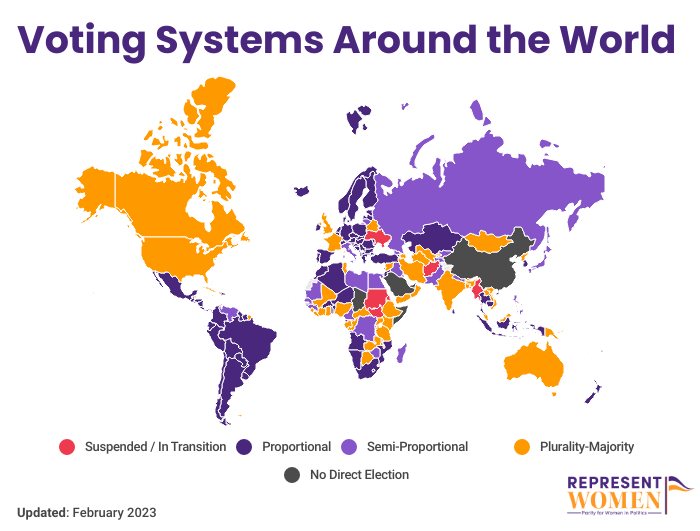Global Lessons: Proportional Voting Systems and Women’s Representation
Electoral systems determine how votes translate into power. Certain systems result in broader representation and give voters greater power in electing their representatives
Around the world, women’s representation in politics continues to suffer. According to United Nations Secretary General Antonio Guterres, gender equality is not only 300 years away, but it is “vanishing before our eyes.” Women’s rights continue to be rolled back, gender stereotypes persist, and gender-balanced governance has yet to be established as an international norm.
Diversity in politics is important for many reasons
Whoever is at the table when decisions are made impacts whose concerns are addressed, what approaches are used, and the creativity of solutions offered. Women bring issues to the table beyond what are typically deemed as exclusively “women’s issues.” That’s because women approach challenges differently than men. The foundations of American democracy rely on inclusive civil discourse – discourse that is ineffective when a plethora of perspectives are excluded.
The ultimate gatekeeper: our electoral system
RepresentWomen’s research shows that one of the biggest determinants of who wins elections is the electoral system. These systems dictate how ballots are counted, who is on the ballot, how voters strategize, and the amount of power voters have. The same ballots cast in different electoral systems – plurality at-large vs winner-take-all districts vs ranked choice voting vs proportional representation – can yield completely different results, in terms of who gets elected.
RepresentWomen tracks and analyzes women’s representation both in the United States and around the world to build evidence regarding the best practices for gender balance in politics. On International Women’s Day (March 8th), we released our International Voting Systems Memo: “Voting Systems and Women’s Representation: Lessons from Around the World and the Case for Proportional Ranked Choice Voting in the United States. That report takes a deeper look into the link between electoral systems and the representation of women in elected office.
Countries around the world have successfully used proportional voting methods for almost a century. While the use of proportional voting may seem new to the United States, proportional systems in the States actually goes back to the Progressive Era in New York, as mentioned in our memo. This memo compliments RepresentWomen’s existing international research by analyzing three cases where a plurality-majority system, which is currently used in the United States, was replaced with proportional representation (PR): New Zealand, South Africa, and localities in the United States.
In the case of New Zealand and South Africa where party-based PR systems were introduced, women's representation increased following the adoption of PR and then rose again with the adoption of gender quotas in party nominations.
New Zealand in particular uses a mixed-member proportional (MMP) system. MMP combines elements of single-winner and proportional representation systems; each voter casts two votes. One vote for a preferred candidate to represent your district, and one for a preferred political party. Winning candidates are awarded district seats (electoral MPs), and the remaining seats are allocated to a party’s list of candidates. A party wins an overall percentage of seats that corresponds to their percentage of the popular vote. Women’s representation rose after the implementation of an MMP system, and again after the adoption of gender quotas.
The most impactful takeaways from our International Voting Systems Memo are:
Women are better represented in countries with proportional voting. Of 193 countries, 84 have proportional representation. On average, women hold on average 31% of all parliamentary seats in countries with proportional representation. Some countries are much higher than that, including New Zealand where women hold 50% of the seats, Costa Rica with 47%, Sweden, Norway and Finland with 46%, Belgium, Spain and Switzerland with 42%, Netherlands and Austria with 40%, Chile with 36% and more. On average, women hold 25% of seats in parliaments worldwide.
Not only that, women are also least represented in countries with plurality-majority systems– the system used in the United States. Compared to the 25% global average, women hold only 19% of seats in parliament in countries with plurality-majority systems.
Additionally, pairing any kind of voting system with gender quotas in party nominations yields even better levels of representation for women in parliament.
Most countries ranked above the U.S. have some form of gender quotas. Of the 73 countries that are either tied with or rank above the U.S. for gender balance in politics, 81% have some form of gender quota in their party nominations.
Women are best represented in countries that combine PR with gender quotas. Of 193 countries, 72 have both proportional representation and gender quotas– usually set at around 30%. In these countries, women hold on average 32% of parliamentary seats, with many nations much higher (see the chart below). By contrast, of the 43 countries with plurality-majority systems and no gender quotas for party nominations, including the United States, women hold just 17% of parliamentary seats.
In sum, our memo furthers the evidence of the vital role that electoral systems play in leveling the playing field for all candidates, including women. As already demonstrated around the world, a reformed electoral system – specifically proportional representation, combined with parties’ gender quotas for candidate nominations – would lead to better representation for women in the United States and significantly advance progress toward gender-balanced governance.
But how would this work in the US context?
In the United States, forms of PR which are candidate-based and not so party-centric are more compatible with our political culture. At the local level, two-thirds of elections are nonpartisan and therefore would conflict with the types of PR where parties set the candidate list, for example. RepresentWomen advances proportional ranked choice voting (P-RCV), which combines ranked choice voting with multi-member districts, as the most viable and transformative form of PR that is compatible with US political dynamics.
Proportional Ranked Choice Voting and Representation
P-RCV is the most effective method to improve women’s representation because, besides being a proportional voting method, it also circumvents party leaders and puts more power in the hands of voters. Party leaders often act as gatekeepers and historically have excluded women candidates.
P-RCV also eliminates the ‘spoiler effect,’ in which many voters waste their vote on a candidate with little chance of winning, and that in turn encourages non-traditional candidates to run. P-RCV boosts campaign civility by incentivizing candidates to reach out to the supporters of other candidates and ask for their second or third ranking. It also has a tendency to decrease campaign costs. All of these factors help to remove barriers for women candidates and create a more level playing field.
Even further, this form of PR promotes issue-focused campaigns and empowers voters to select a candidate that they genuinely want, instead of the candidate they think has the best chance, thus eliminating strategic voting. When we combine these impacts of P-RCV, our research shows that more women run and win.
Furthermore, our research shows that when we embrace what RepresentWomen calls the “twin-track” approach, which combines the power of building a pipeline of women candidates with systems-level strategies to remove barriers for women to run and win, we are confident that we can achieve gender balance in our lifetimes.
There is a clear link between electoral systems and women’s representation around the world. Over and over again, countries with plurality-majority systems, like the United States, were found to have the lowest rates of women's representation in the world, while countries with some level of PR voting systems have the highest representation rates worldwide.
The United States currently ranks 71st in women’s representation globally. Twenty years ago, we ranked 63rd. Other countries, unlike the United States, implemented the aforementioned reforms that helped them to rise through the ranks. If we want to achieve sustainable and authentic gender balance, we need to invest in systems strategies at the same rate that we invest in building a pipeline of women candidates. Of course not all reforms will yield the same results in all countries or localities, but this only reinforces the value of the twin-track approach – that reinforcing reforms and efforts must be implemented in tandem to yield the most sustainable and transformative results.
The benefits of PR impact all candidates and voters. However, women are exponentially uplifted because they have been structurally disadvantaged for so long. Progress towards gender balance is slow and inconsistent, but with P-RCV, which puts voters at the forefront, we can achieve gender balance within our lifetimes.
Alissa Bombardier Shaw @alissashaw_ and Steph Scaglia @ScagliaSteph







